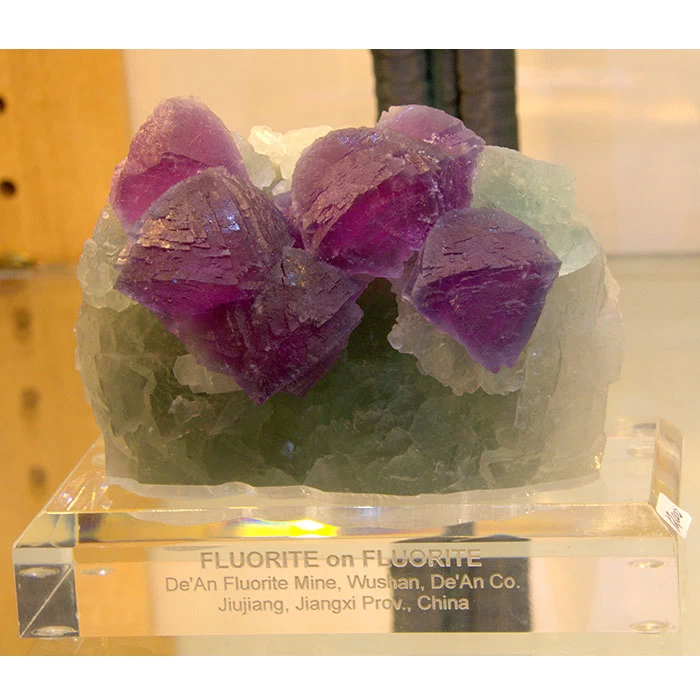Fluorite: Properties, Facts and Photos

Fluorite is often described as the most colourful mineral in the world. Being soft and fragile, it can chip or fracture easily. Prolonged exposure to natural daylight can cause the colour of some fluorite to fade.
| Contents 1. What is Fluorite? 2. Where is Fluorite Found? 3. The Meaning of Fluorite 4. Article Pictures 5. Shop Fluorite |
What is Fluorite?
Fluorite is a natural mineral composed of calcium and fluorine. It represents one of the widest ranges of colour of any natural mineral.
Although often described as 'the most colourful mineral in the world,' fluorite is colourless in its purest form. It changes colour due to impurities in its crystal structure and natural geological processes such as radiation.
The most common hues of fluorite are yellow, green, blue, and purple, but it can also be white, pink, reddish-orange, brown, and even black.
Fluorite's colours can be bright and vibrant, but will fade gradually if exposed to excessive heat or sunlight. The colours are best appreciated when the crystal is held up towards the light.
The exact cause of green fluorite is still debated. It's generally linked to trace impurities such as chromium or vanadium, and in some cases to exposure to natural radiation.
Fluorite crystals are transparent or translucent with a vitreous lustre. When largely free from impurities, they're composed of 51.1% calcium and 48.9% fluorine.
With impurities come small amounts of silicon, aluminium and magnesium. Gases and fluids such as petroleum and water may also be present.
Although fluorite crystals tend to be well-formed and often occur as cubes, they also crystallise in masses. In this crystal habit, crystals grow tightly together to form one large, shapeless mass.
The ability of fluorite to fluoresce when exposed to ultraviolet light has been well documented. The word 'fluorescent' came about because this optical phenomenon was first observed in the mineral fluorite.
Specific impurities within the mineral's crystal structure cause fluorescence. Not all fluorite crystals fluoresce, even if obtained from the same deposit.

Where is Fluorite Found?
Fluorite is found in a wide range of geological environments and in many places around the world. Only a handful of deposits have produced large quantities of fine-grade gemstones.
Fluorite is often found alongside lead and zinc minerals in hydrothermal veins.
Some of the finest crystals come from England, particularly Durham, Cornwall and Cumberland. Castleton in Derbyshire is famous for a rare variety of fluorite known as Derbyshire Blue John. This material cannot be found anywhere else in the world. It occurs in massive form, exhibits bands of yellow and purple colour, and is virtually mined out.
Other notable fluorite deposits are in Germany, Austria, Switzerland, Norway, Mexico and Canada. The state of Illinois in the U.S. was once the world's largest producer, but the last mine closed in 1995.
The Illinois General Assembly passed a bill in 1965 declaring fluorite as its official state mineral.

The Meaning of Fluorite
The meaning of the word 'fluorite' comes from the Latin word 'fluere' meaning 'to flow.' This is because fluorite has a very low melting point.Named in 1797, fluorite is named for the ease with which it melts when used as a flux in the smelting and refining of metals. A flux is a substance added to a furnace or smelting process that helps melt ores, removes impurities, and promotes a desired chemical reaction.
Fluxes are important to various metallurgical processes because they provide specific properties and benefits.
Fluorite, also known as fluorspar, is widely used in industry. It's used in the manufacture of fibreglass, ceramics and opaque glass. It's also used in the chemical, iron and steel industries.
Fluorite is the mineral form of calcium fluoride and an important industrial source of fluorine. Fluorine compounds derived from fluorite are used in a wide range of applications, including water fluoridation. It's used in toothpaste because of its ability to fight cavities, and Teflon, the non-stick surface in cooking pans.
Fluorite is known to have been used in ancient Egypt and was also mined by the Romans. Two fluorite cups from around 50 -100 AD are housed in the British Museum.

.
Article Pictures
The fluorite in photos 2, 3, and 4: Stone Mania.
The fluorite at the top of our article is courtesy of Steve Blyskal. The fluorite gemstones are on display at the Harvard Museum of Natural History, Massachusetts, USA.
The third photo was taken in the Smithsonian Museum of Natural History in Washington, D.C.
The fluorite terminated point in the last photo is from our collection.






